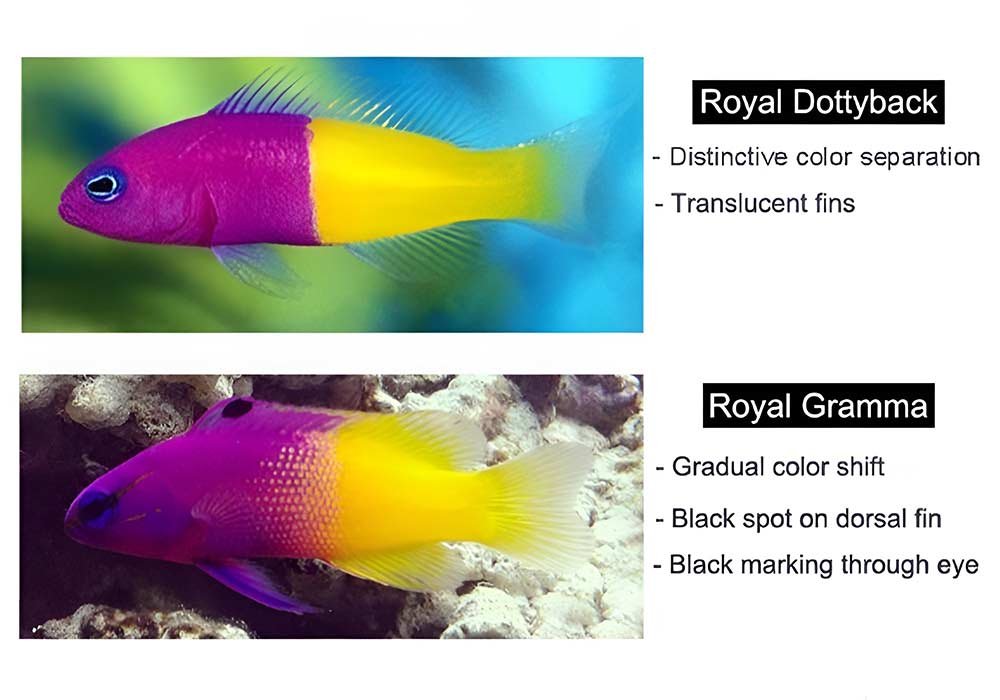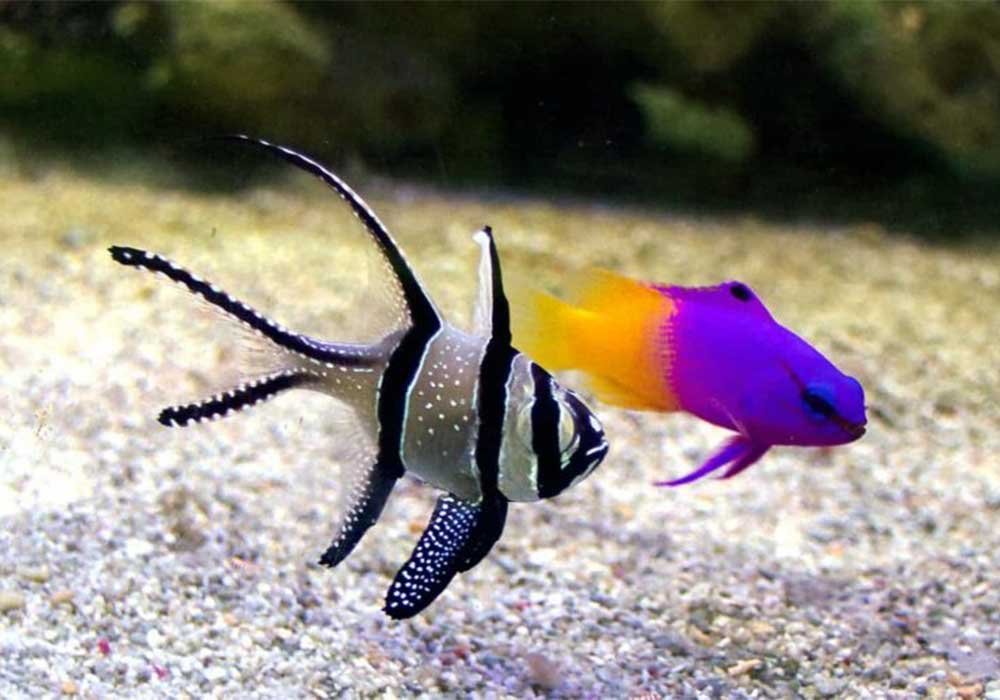Hey there, aquarium enthusiasts! If you’re looking to add a splash of color to your saltwater tank, the royal gramma basslet, also known as the fairy basslet, is like a living jewel that’ll steal the show. Picture this: a vibrant purple front fading into a sunny yellow tail, darting through your tank like a little underwater rainbow. If glofish have caught your eye for their neon glow, the royal gramma (scientifically Gramma loreto) brings that same wow factor but with a natural, oceanic flair.
In this blog, we’re diving deep into everything you need to know about caring for a royal gramma basslet, from their diet to their tank mates, lifespan, and more. Let’s make sure your tank is ready to welcome this multicolored gem!
| Name (Common, Scientific) | Royal gramma, fairy basslet, Gramma loreto |
| Minimum tank size | 30 gallons |
| Minimum group size | 1-2 |
| Temperature | 72-78 °F |
| Salinity | 1.020-1.025 |
| pH | 8.1-8.4 |
| Difficulty level | Easy |
Table of Contents
What Makes the Royal Gramma Basslet So Special?
The Gramma loreto fish, or royal gramma basslet, is a stunner from the tropical waters of the Caribbean and western Atlantic. Its bold purple-to-yellow gradient, black eye stripe, and dorsal fin eyespot make it a standout in any reef tank. But it’s not just about looks—this fish is hardy, relatively easy to care for, and perfect for beginners and seasoned aquarists alike. Unlike some flashy fish that demand expert-level care, the fairy basslet is forgiving, making it a go-to for anyone wanting to add vibrancy without the headache.
Here’s why the royal gramma is a tank favorite:
- Vivid Colors: The purple front blends into a yellow tail, creating a gradient that’s almost magical under aquarium lights.
- Compact Size: Growing to about 3 inches (8 cm), they’re ideal for nano tanks (minimum 30 gallons recommended).
- Reef-Safe: They won’t nibble on your corals or bother larger invertebrates, making them a dream for reef setups.
- Unique Behavior: Ever seen a fish swim upside-down? Royal grammas do this under ledges, a quirky trait that adds personality to your tank.
Fun Fact:
In the wild, royal grammas are protogynous hermaphrodites—all are born female, but dominant ones can turn male, growing slightly larger with more vivid colors.
How to Feed Your Royal Gramma for a Healthy Diet?
When it comes to the royal gramma diet, these little carnivores aren’t picky, but they do have preferences that keep them thriving. In the wild, Gramma loreto fish are planktivores, munching on zooplankton, crustaceans, and fish eggs. In your tank, you’ll want to mimic this diet to keep their colors popping and their energy high.
Here’s how to nail their diet:
- Meaty Foods: Offer live or frozen foods like brine shrimp, mysis shrimp, or copepods. These are their favorites and mimic their natural prey.
- Prepared Foods: They’ll accept vitamin-enriched flakes or pellets, but mix these in sparingly to keep things varied.
- Feeding Frequency: Feed small amounts 1-2 times daily, placing food near their hiding spots since they love to dart out and grab it.
- Pro Tip: Use a feeding tool like a gourmet defroster to release frozen food gradually into the water column, perfect for their planktivore habits.
Fun Tip:
Rotate their diet to prevent boredom. A varied menu keeps them healthy and active, plus it’s fun to watch them chase down different foods!
What’s the Lifespan of a Royal Gramma Basslet?
Wondering about the royal gramma lifespan? With proper care, these fish can live 5-6 years in captivity, sometimes even longer. Their longevity depends on a few key factors that you can control to ensure they stick around as long as possible.
To maximize their lifespan:
- Stable Water Conditions: Keep water temperature between 72-80°F, pH at 8.1-8.4, and specific gravity at 1.020-1.025. Weekly water tests are a must.
- Low Stress: Provide plenty of hiding spots with live rock or caves to reduce stress from tank mates or sudden movements.
- Quality Diet: A varied, high-protein diet supports their immune system and vibrant colors.
- Regular Maintenance: Change 10% of the tank water weekly to keep nitrates low and water pristine. Fading colors can signal poor water quality, so act fast if you notice this.
Research Insight:
Studies show royal grammas are sensitive to lionfish predation in the wild, but in a controlled tank environment, their main threats are stress and poor water conditions. Keep these in check, and your fairy basslet will thrive.
How to Spot a Royal Gramma vs. a Dottyback Purple?

One common mix-up in the aquarium world is confusing the royal gramma with the Pictichromis paccagnellae, aka the royal dottyback or purple dottyback. Both sport a purple-and-yellow look, but they’re worlds apart in temperament and care needs. The royal gramma is peaceful; the dottyback? Not so much—it’s aggressive and can bully tank mates.
Here’s a quick guide to tell them apart:
| Feature | Royal Gramma (Gramma loreto) | Royal Dottyback (Pictichromis paccagnellae) |
| Color Transition | Gradual purple-to-yellow gradient | Sharp, abrupt purple-to-yellow line |
| Dorsal Fin Spot | Black eyespot present | No black spot |
| Eye Stripe | Black line through eye | No black line |
| Fin Color | Purple or blue-edged fins | Clear fins |
| Temperament | Peaceful, shy | Aggressive, territorial |
Pro Tip:
Always double-check at the fish store to avoid bringing home a dottyback by mistake. A dottyback’s aggression can disrupt your peaceful tank vibe.
Who Are the Best Royal Gramma Tank Mates?

Choosing royal gramma tank mates is all about harmony. These fish are peaceful but territorial, especially with their own kind or look-alikes. A poorly chosen tank mate can stress them out, sending them into hiding or worse. Here’s how to build a happy community tank.
Great Tank Mates:
- Clownfish (Amphiprioninae): Their playful antics complement the gramma’s chill vibe.
- Gobies (Gobiidae): Small, peaceful, and bottom-dwellers, they don’t compete for space.
- Angelfish (Pygmy species like Centropyge): Choose non-purple ones to avoid territorial spats.
- Blue Green Chromis (Chromis viridis): Non-aggressive damselfish that add sparkle without drama.
- Invertebrates & Corals: Royal grammas are 100% reef-safe, ignoring shrimp, crabs, and corals.
Tank Mates to Avoid:
- Other royal grammas (unless in a large tank with a male-female pair or harem).
- Royal dottybacks or similar purple/yellow fish (triggers aggression).
- Large predators like lionfish (Pterois sp.), groupers, or eels that might see them as lunch.
- Aggressive fish like most damselfish or territorial hawkfish.
Magic Tip:
Introduce multiple royal grammas simultaneously in a tank of 55 gallons or larger to reduce territorial fights. Each fish needs its own cave or crevice to claim.
How to Care for a Royal Gramma Basslet Like a Pro?
Caring for a royal gramma basslet is straightforward, but a few expert tips can elevate your game. These fish thrive in a well-planned tank that mimics their natural Caribbean reef habitat. Here’s your blueprint for success.
Tank Setup:
- Minimum Size: 30 gallons for one; 55+ gallons for pairs or harems.
- Hiding Spots: Pile up live rock, coral outcroppings, or artificial caves. They love darting into crevices.
- Lighting: Subdued lighting mimics their deep-water habitat. Avoid harsh, direct light.
- Water Flow: A strong current from a power filter replicates their reef environment.
Behavior Management:
- Territorial Quirks: Royal grammas may “gape” (open their mouths wide) to scare off intruders. This is normal but watch for excessive aggression.
- Upside-Down Swimming: Don’t panic if they swim belly-up under ledges—it’s their signature move
- Jumping Risk: Use a tight-fitting lid, as these fish are known to leap when startled.
Health Monitoring:
- Watch for Fading Colors: A sign of stress or poor water quality. Test and adjust parameters immediately.
- Quarantine New Fish: If you spot marine ich, move them to a quarantine tank for 9 weeks to treat safely.
- Acclimation: Use a drip acclimation method and introduce them via a mesh tube or acclimation box to reduce stress.
Research Insight:
Royal grammas are cave-spawners in the wild, with males building nests from macroalgae. Breeding in captivity is possible but tricky—set up a separate tank with plenty of hiding spots if you want to try.
Curious Minds Ask: Your Royal Gramma Questions Answered
What’s Next for Your Aquarium Adventure?
The royal gramma basslet is your ticket to a vibrant, lively reef tank that’s easy to maintain and a joy to watch. With their stunning colors, quirky behaviors, and beginner-friendly care needs, they’re a must-have for any aquarist.
But the journey doesn’t stop here! Stay tuned for our next blog, where we’ll dive into creating the ultimate reef tank setup—think corals, lighting, and more colorful fish to complement your royal gramma.
Got a favorite tank mate or a pro tip for caring for a royal gramma? Drop it in the comments, and let’s keep the aquarium vibes flowing!


